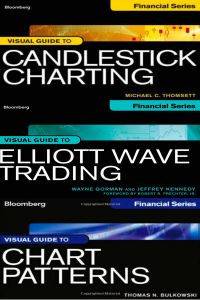Visual Guide to Candlestick Charting Bloomberg Financial Series
Visual Guide to Candlestick Charting thuộc Bloomberg Financial Series. Sách hình ảnh màu với rất nhiều ví dụ có chú thích rất trực quan sinh động về đồ thị nến Nhật.
Đặt in thành sách tại HoaXanh, xem sách in mẩu trong video bên dưới.
- 160,000đ
- Mã sản phẩm: VIS102004
- Tình trạng: 2
Today, a majority of chartists and technicians are familiar
with candlestick charting patterns. However, many
chartists are not certain about how to interpret the dozens
of indicators found through candlestick analysis, or
how to use candlesticks along with other indicators to
confi rm reversal and continuation forecasts. Th is has
led to the desire among traders for a consistent, reliable,
and powerful system that supplies them with more and
better information.
As a part of this desire among traders for more and
better information, the enthusiasm for candlesticks as
informative representations of price movement is due to
their many attributes, including:
1. Instant recognition. Th e signifi cance of a series of
candlesticks is recognizable at a glance. A strong
upward or downward movement is visible not only
because of the direction of price trends, but also
because of the color of candlesticks. Th e strength
or weakness of momentum is further visible in the
evolving height of candles, the volatility of trading
range, and the special meaning of exceptionally large
or small sessions.
2. Valuable confi rmation. Technicians know that any
indications of signifi cance (breakout and a new trading
range, resistance or support testing, and gapping
action, for example) need to be confi rmed before entry
or exit should occur. But how do you confi rm and
then decide before the important and expected price
movement takes place? Th e answer is found in candlesticks.
Anticipating price movement rather than
following it helps every trader improve the timing of
entry and exit through the use of candlesticks to confi
rm traditional charting patterns and indicators.
3. Variety of indications. Th ere are dozens of candlestick
indicators, and each has a specifi c name. How many?
Th is book defi nes and illustrates approximately 200
candlesticks and related terms. Th e distinction between
the number of sessions involved with a particular
candlestick indicator can be confusing; for this
reason, the terms used in this book are “sign” (single
candlestick), “move” (two-session indicators), and “pattern”
(three sessions). While the time span of sessions
may vary from seconds or minutes up to hours, days, or
even weeks, the chart examples provided in this book
are those of daily charts; and the sessions are described
as “days”—however, the observations of indicators and
their meaning apply equally to charts of all durations.
4. Applicability for a range of trading purposes. Candlestick
signs, moves, and patterns provide valuable
price movement insight for a range of purposes. Th ese
can be used not only as confi rmation tools, but also
to augment day trading or swing trading strategies,
timing of options trades, identifi cation if current price
volatility, and even for timing of purchases as part of a
value or growth investing strategy.
Th is book provides a convenient and easy-to-use
summary of candlestick patterns. It is arranged in the
following chapters:
???? Types of charts. Candlesticks are the most valuable of
charting systems; this section compares them to line
charts and OHLC varieties.
???? Th e history of candlesticks. Here are brief explanations
of where Japanese candlesticks were fi rst used
and how they became popular in American technical
analysis.
???? Candlesticks and their attributes. Th is is a summary of
the parts of the candlestick and what each reveals, in
terms of shape, size, and color.
???? Pitfalls of candlesticks. Like all systems, candlesticks
cannot guarantee 100 percent accuracy in timing of
entry or exit. Th ey can provide improvement over analytical
skills and the timing of entry and exit. However,
traders should be aware of the pitfalls within the world
of candlesticks as well as the advantages.
???? Confi rmation. Th e key to all technical analysis is confi
rmation, the verifi cation of what one indicator reveals
with the same prediction off ered by a separate
indicator.
???? Th e six basic candlesticks. Although there are dozens
of possible candlestick indicators and combinations,
they all consist of combining six basic candle types.
???? Candlestick alphabetical entries. Th is section contains
entries with descriptions as well as two illustrations
for each: a small view of the candlestick followed by an
actual example on a chart of one of 50 selected stocks.
???? Noncandlestick confi rmation indicators and terms.
Th ese are traditional Western indicators (as opposed
to Eastern, or candlestick types) used to confi rm what
candlesticks fi rst predict, or that predict changes that
are then confi rmed by candlestick indicators. Th e section
also explains principles of technical analysis related
to overall methods, or to both Eastern and Western
charting techniques.
???? Answers to Test Yourself, for e-book users, are provided
through the previous sections of the e-book. Th ese
consist of multiple-choice, true/false, and chartcompletion
exercises.
???? Bloomberg systems. A brief explanation of how the
Bloomberg terminal provides basic keystroke commands
to begin the process of using candlesticks and
their charts.





